Failure Behaviour of Jointed Rock Masses with 3D Nonpenetrating Joints under Uniaxial Compression: Insights from Discrete Element Method Modelling
Abstract
:1. Introduction
2. Model Setup and Microparameter Calibration
3. Results and Discussion
3.1. Strength and Failure Modes
3.2. Failure Characteristics
3.3. Stress Field on the Joint Plane
4. Conclusions
- (1)
- For the strength of the jointed specimens, the numerical results show great agreement with those obtained from the laboratory tests. The peak strength of specimens with θ = 45°–75° is significantly affected by the joint persistence. However, when θ ≤ 45° or θ = 90°, the joint persistence plays a small role in the strength of the specimens.
- (2)
- Based on microcrack accumulation and evolution, four typical failure processes (shear failure, split failure, mixed failure, and intact failure) are analysed from the micro perspective. As the joint persistence increases, for the specimen belonging to the shear failure mode, the axial strain at which the proportion of tensile and shear failures reaches a stable level decreases continuously. However, for the specimen belonging to split and intact failure, it is basically the same.
- (3)
- The stress distribution in rock bridges was monitored and analysed. For the specimen belonging to splitting failure and intact failure, the variation in the stress concentration area is very slight. For the slip fracture mode or mixed fracture mode, slip occurs along the joint plane during specimen failure, and as the joint plane is staggered, the shear stress distribution area also changes accordingly.
Author Contributions
Funding
Data Availability Statement
Conflicts of Interest
References
- Erdogan, F.; Sih, G.C. On the Crack Extension in Plates Under Plane Loading and Transverse Shear. J. Basic Eng. 1963, 85, 519–525. [Google Scholar]
- Yang, S.Q.; Dai, Y.H.; Han, L.J.; He, Y.N.; Li, Y.S. Uniaxial compression experimental research on deformation and failure properties of brittle marble specimen with pre-existing fissures. Chin. J. Rock Mech. Eng. 2009, 28, 2391–2404. [Google Scholar]
- Wang, G.L.; Zhang, L.; Xu, M.; Liang, Z.Y.; Ran, B.L. Energy damage evolution mechanism of non-across jointed rock mass under uniaxial compression. Chin. J. Geotech. Eng. 2019, 41, 639–647. [Google Scholar]
- Liu, H.Y.; Su, T.M. A Dynamic Damage Constitutive Model for a Rock Mass with Non-Persistent Joints under Uniaxial Compression. Mech. Res. Commun. 2016, 77, 12–20. [Google Scholar]
- Yuan, X.P.; Liu, H.Y.; Wang, Z.Q. Crack tip plastic zone and elastoplastic fracture model for nonpenetrating jointed rock mass under uniaxial compression. Rock Soil Mech. 2012, 33, 1679–1688. [Google Scholar]
- Shen, B. The Mechanism of Fracture Coalescence in Compression—Experimental Study and Numerical Simulation. Eng. Fract. Mech. 1995, 51, 73–85. [Google Scholar]
- Bobet, A.; Einstein, H.H. Fracture Coalescence in Rock-Type Materials under Uniaxial and Biaxial Compression. Int. J. Rock Mech. Min. Sci. 1998, 35, 863–888. [Google Scholar]
- Dyskin, A.V.; Sahouryeh, E.; Jewell, R.J.; Joer, H.; Ustinov, K.B. Influence of Shape and Locations of Initial 3-D Cracks on Their Growth in Uniaxial Compression. Eng. Fract. Mech. 2003, 70, 2115–2136. [Google Scholar]
- Zhou, X.-P.; Zhang, J.-Z.; Wong, L.N.Y. Experimental Study on the Growth, Coalescence and Wrapping Behaviors of 3D Cross-Embedded Flaws Under Uniaxial Compression. Rock Mech. Rock Eng. 2018, 51, 1379–1400. [Google Scholar]
- Yang, S.-Q.; Liu, X.-R.; Jing, H.-W. Experimental Investigation on Fracture Coalescence Behavior of Red Sandstone Containing Two Unparallel Fissures under Uniaxial Compression. Int. J. Rock Mech. Min. Sci. 2013, 63, 82–92. [Google Scholar]
- Sarfarazi, V.; Ghazvinian, A.; Schubert, W.; Blumel, M.; Nejati, H.R. Numerical Simulation of the Process of Fracture of Echelon Rock Joints. Rock Mech. Rock Eng. 2014, 47, 1355–1371. [Google Scholar]
- Yang, S.-Q.; Huang, Y.-H.; Jing, H.-W.; Liu, X.-R. Discrete Element Modelling on Fracture Coalescence Behavior of Red Sandstone Containing Two Unparallel Fissures under Uniaxial Compression. Eng. Geol. 2014, 178, 28–48. [Google Scholar]
- Cao, R.; Cao, P.; Lin, H.; Pu, C.; Ou, K. Mechanical Behavior of Brittle Rock-Like Specimens with Pre-Existing Fissures Under Uniaxial Loading: Experimental Studies and Particle Mechanics Approach. Rock Mech. Rock Eng. 2016, 49, 763–783. [Google Scholar]
- Fan, X.; Kulatilake, P.H.S.W.; Chen, X. Mechanical Behavior of Rock-like Jointed Blocks with Multi-Non-Persistent Joints under Uniaxial Loading: A Particle Mechanics Approach. Eng. Geol. 2015, 190, 17–32. [Google Scholar]
- Fu, J.-W.; Chen, K.; Zhu, W.; Zhang, X.; Li, X. Progressive Failure of New Modelling Material with a Single Internal Crack under Biaxial Compression and the 3-D Numerical Simulation. Eng. Fract. Mech. 2016, 165, 140–152. [Google Scholar]
- Zhang, H.; Liu, H.Y. Simulation on the Uniaxial Compressive Mechanical Properties of Rock Mass with Nonpersistent and Infilled Joints. Min. Res. Dev. 2017, 37, 87–92. [Google Scholar]
- Wang, Y.; Zhou, X.; Xu, X. Numerical Simulation of Propagation and Coalescence of Flaws in Rock Materials under Compressive Loads Using the Extended Non-Ordinary State-Based Peridynamics. Eng. Fract. Mech. 2016, 163, 248–273. [Google Scholar]
- Wong, R.H.C.; Tang, C.A.; Chau, K.T.; Lin, P. Splitting Failure in Brittle Rocks Containing Pre-Existing Flaws under Uniaxial Compression. Eng. Fract. Mech. 2002, 69, 1853–1871. [Google Scholar]
- Esterhuizen, G.S.; Dolinar, D.R.; Ellenberger, J.L. Pillar Strength in Underground Stone Mines in the United States. Int. J. Rock Mech. Min. Sci. 2011, 48, 42–50. [Google Scholar]
- Shang, J.; Hencher, S.R.; West, L.J. Tensile strength of geological discontinuities including incipient bedding, rock joints and mineral veins. Rock Mech Rock Eng. 2016, 49, 4213–4225. [Google Scholar]
- Cao, R.; Yao, R.; Meng, J.; Lin, Q.; Lin, H.; Li, S. Failure Mechanism of Non-Persistent Jointed Rock-like Specimens under Uniaxial Loading: Laboratory Testing. Int. J. Rock Mech. Min. Sci. 2020, 132, 104341. [Google Scholar]
- Shang, J.; West, L.J.; Hencher, S.R.; Zhao, Z. Geological Discontinuity Persistence: Implications and Quantification. Eng. Geol. 2018, 241, 41–54. [Google Scholar]
- Cao, R.; Yao, R.; Hu, T.; Wang, C.; Li, K.; Meng, J. Failure and Mechanical Behavior of Transversely Isotropic Rock under Compression-Shear Tests: Laboratory Testing and Numerical Simulation. Eng. Fract. Mech. 2021, 241, 107389. [Google Scholar]
- Cao, R.; Cao, P.; Fan, X.; Xiong, X.; Lin, H. An Experimental and Numerical Study on Mechanical Behavior of Ubiquitous-Joint Brittle Rock-Like Specimens Under Uniaxial Compression. Rock Mech Rock Eng. 2016, 49, 4319–4338. [Google Scholar]
- Cundall, P.A. Numerical Experiments on Rough Joints in Shear Using a Bonded Particle Model. In Aspects of Tectonic Faulting; Springer: Berlin/Heidelberg, Germany, 2000; pp. 1–9. [Google Scholar]
- Asadi, M.S.; Rasouli, V.; Barla, G. A Laboratory Shear Cell Used for Simulation of Shear Strength and Asperity Degradation of Rough Rock Fractures. Rock Mech Rock Eng. 2013, 46, 683–699. [Google Scholar]
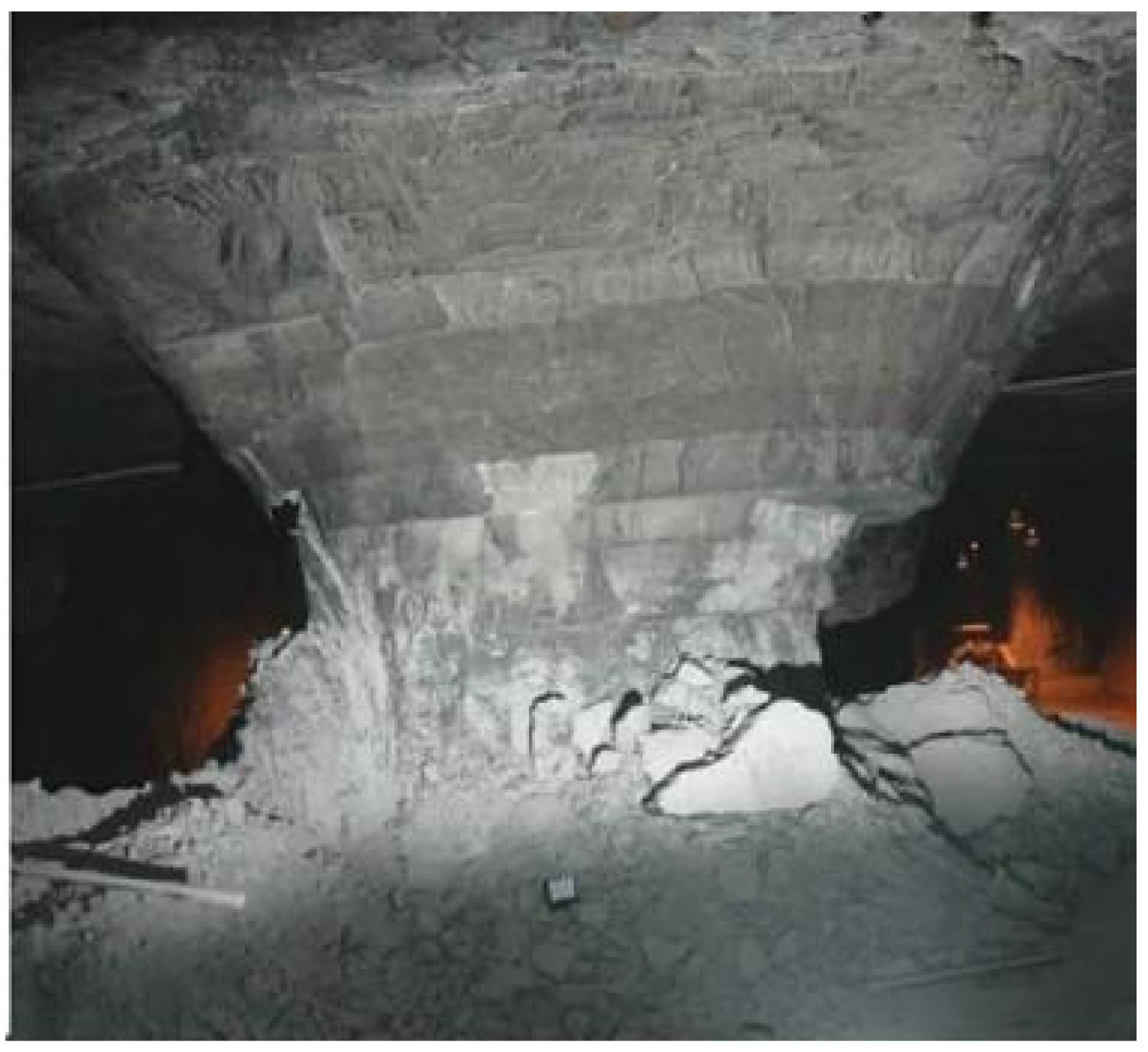
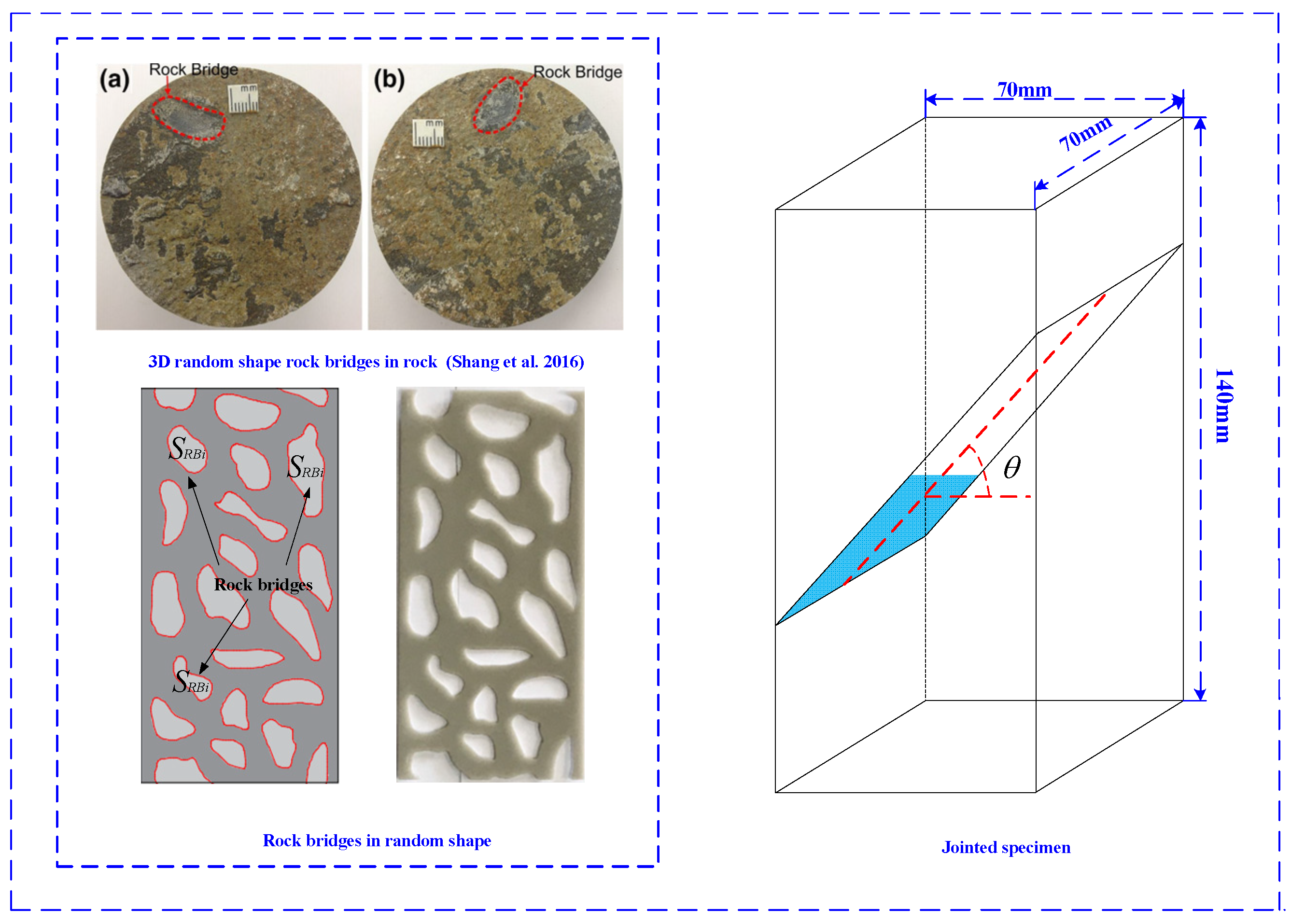
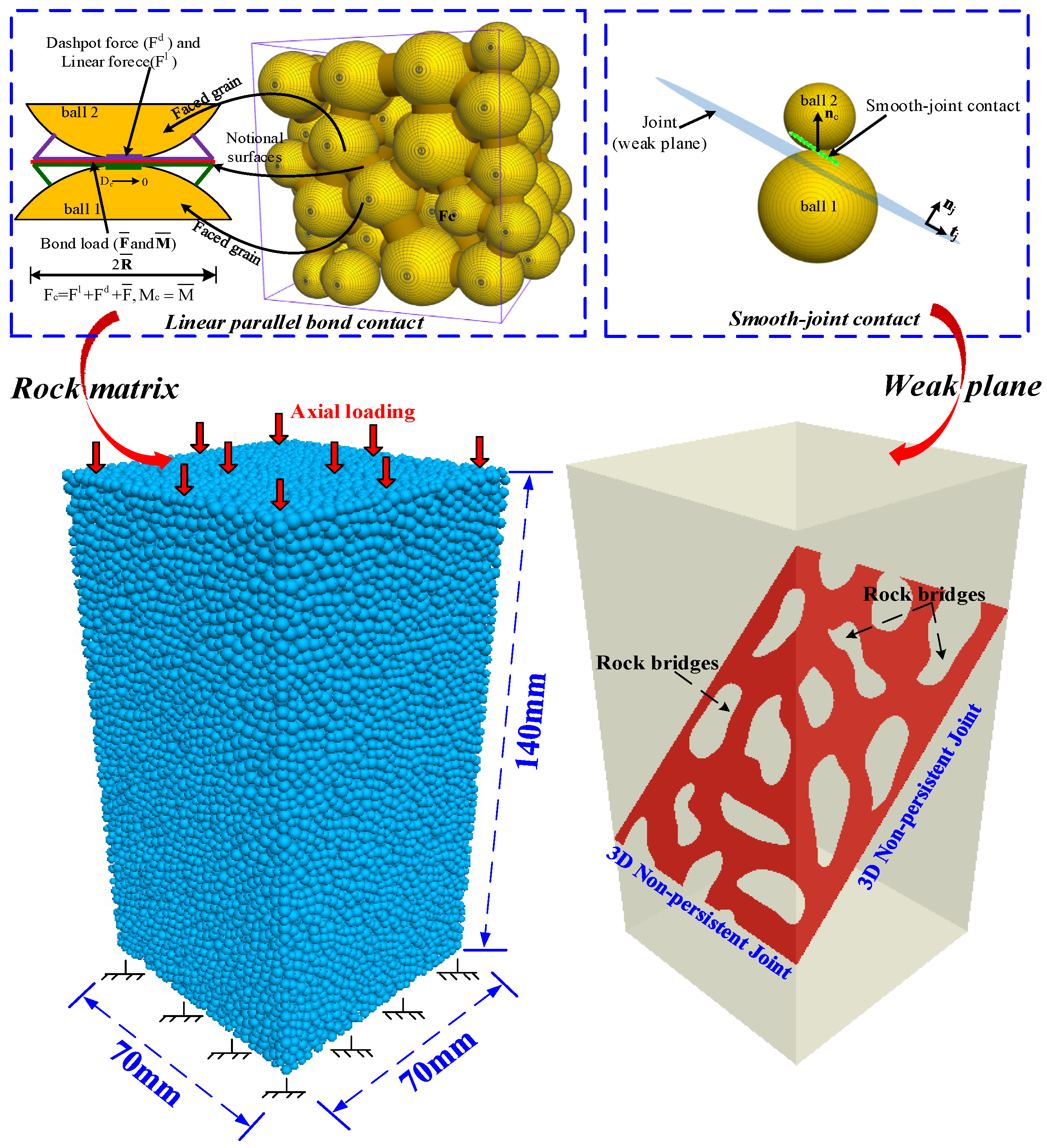
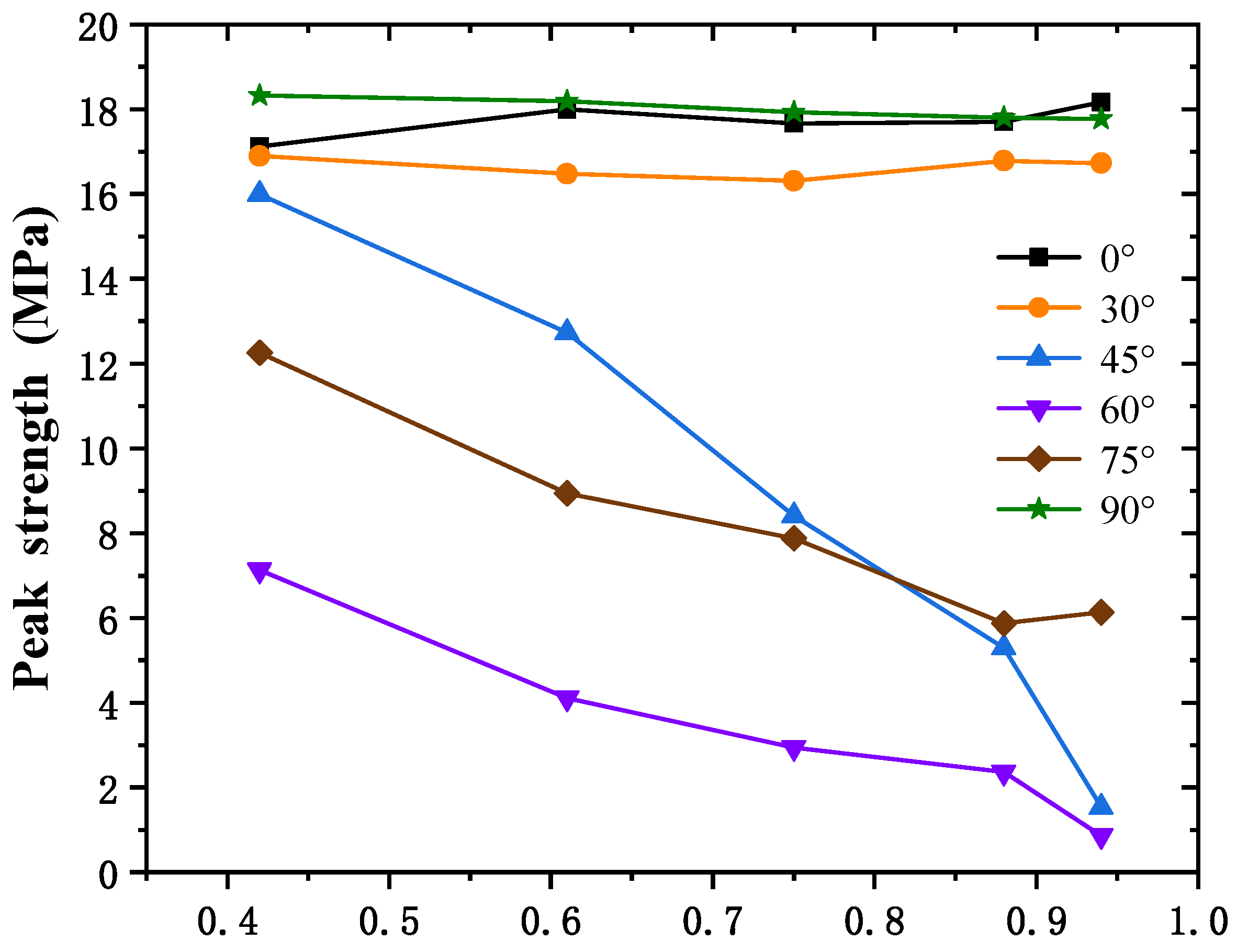


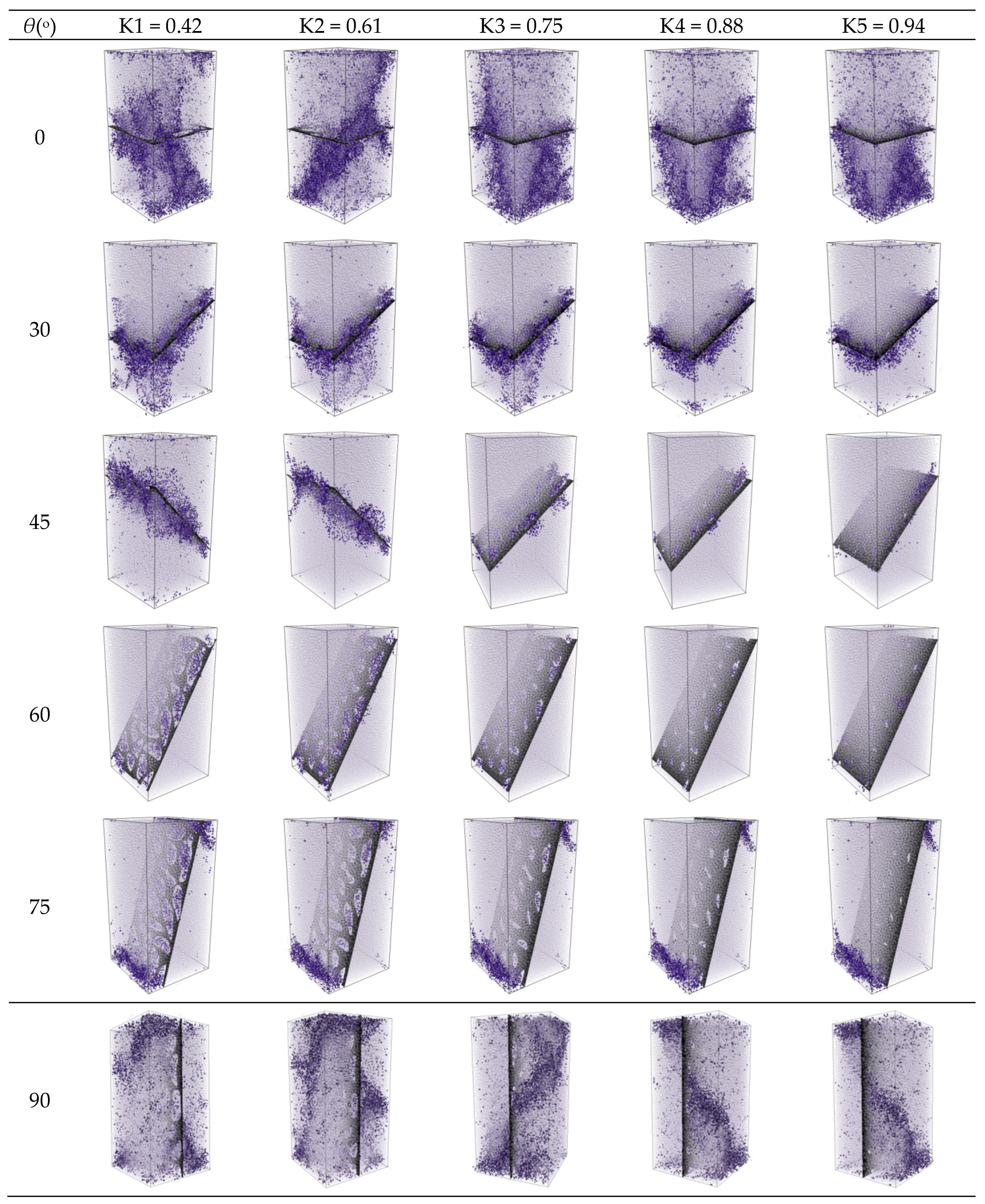



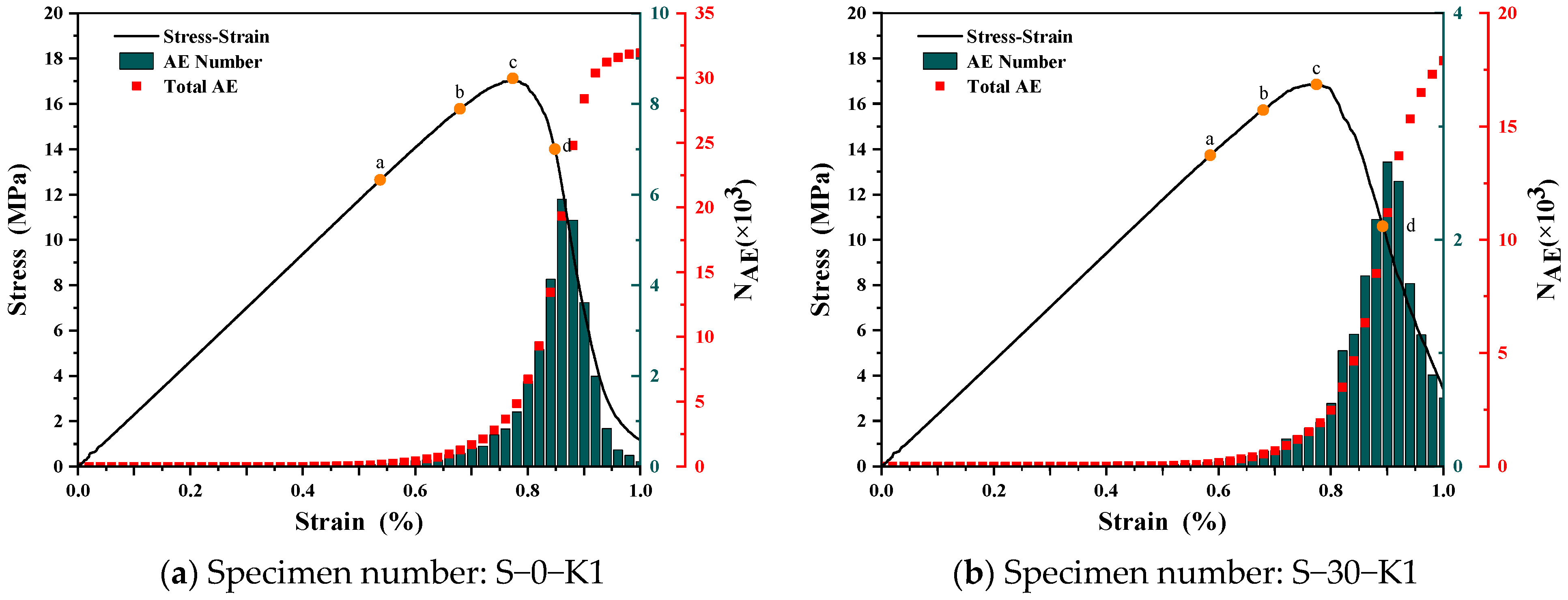


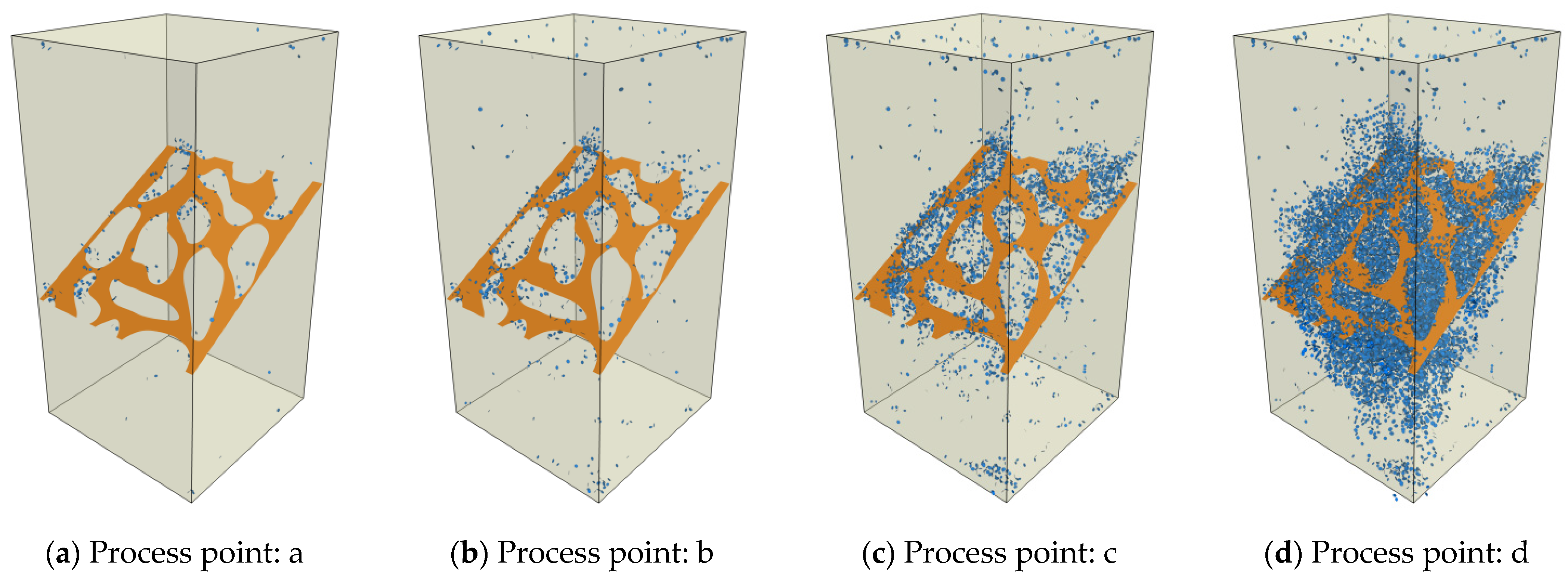

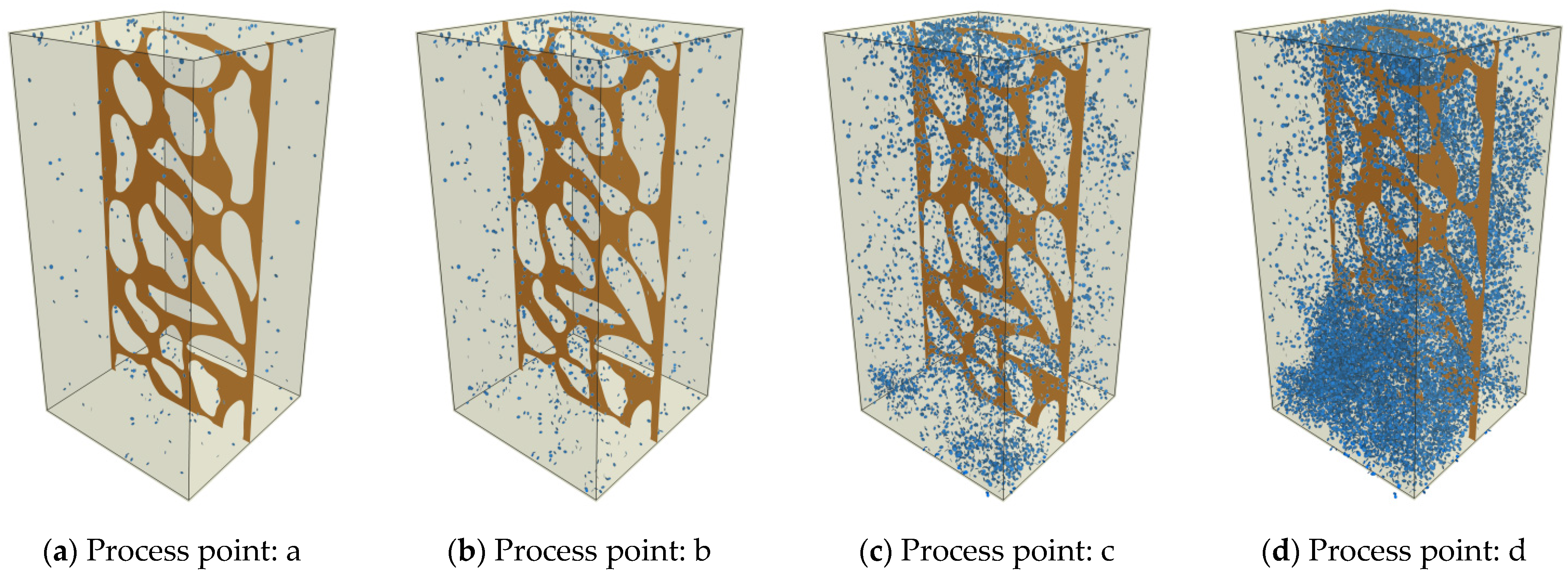
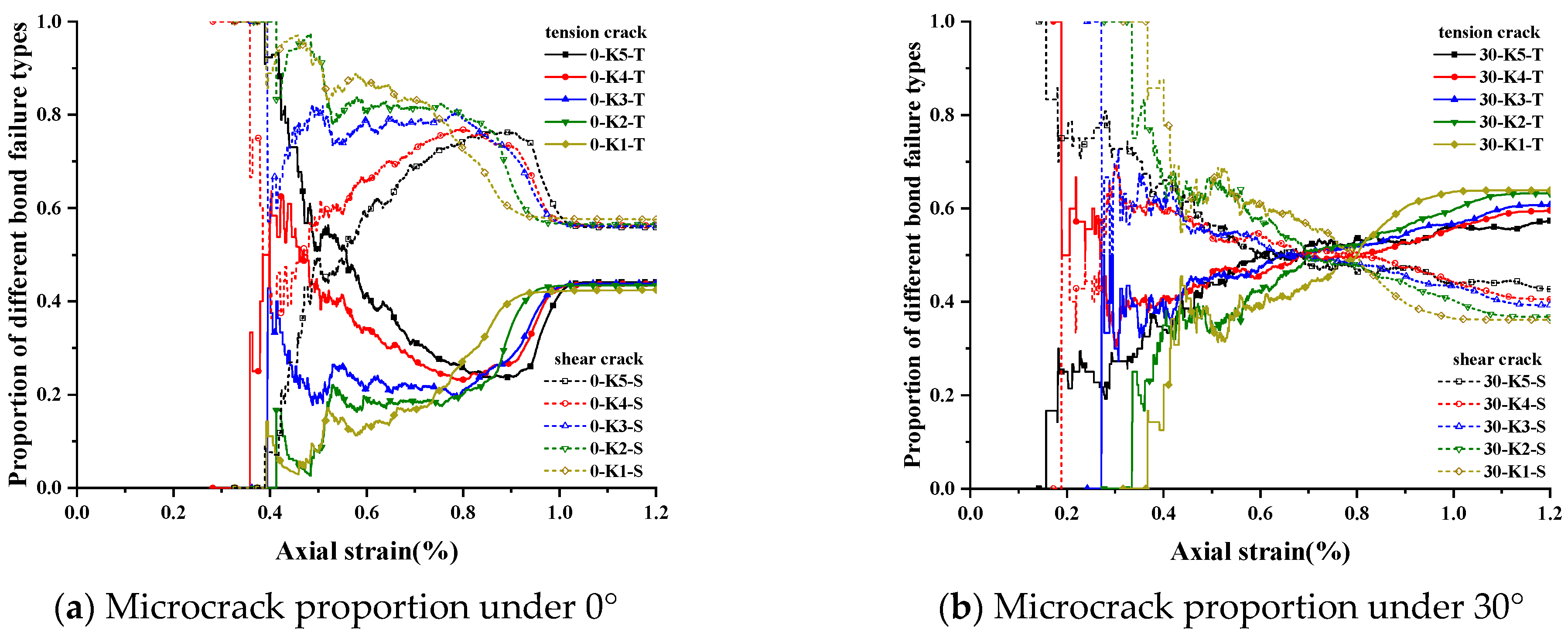
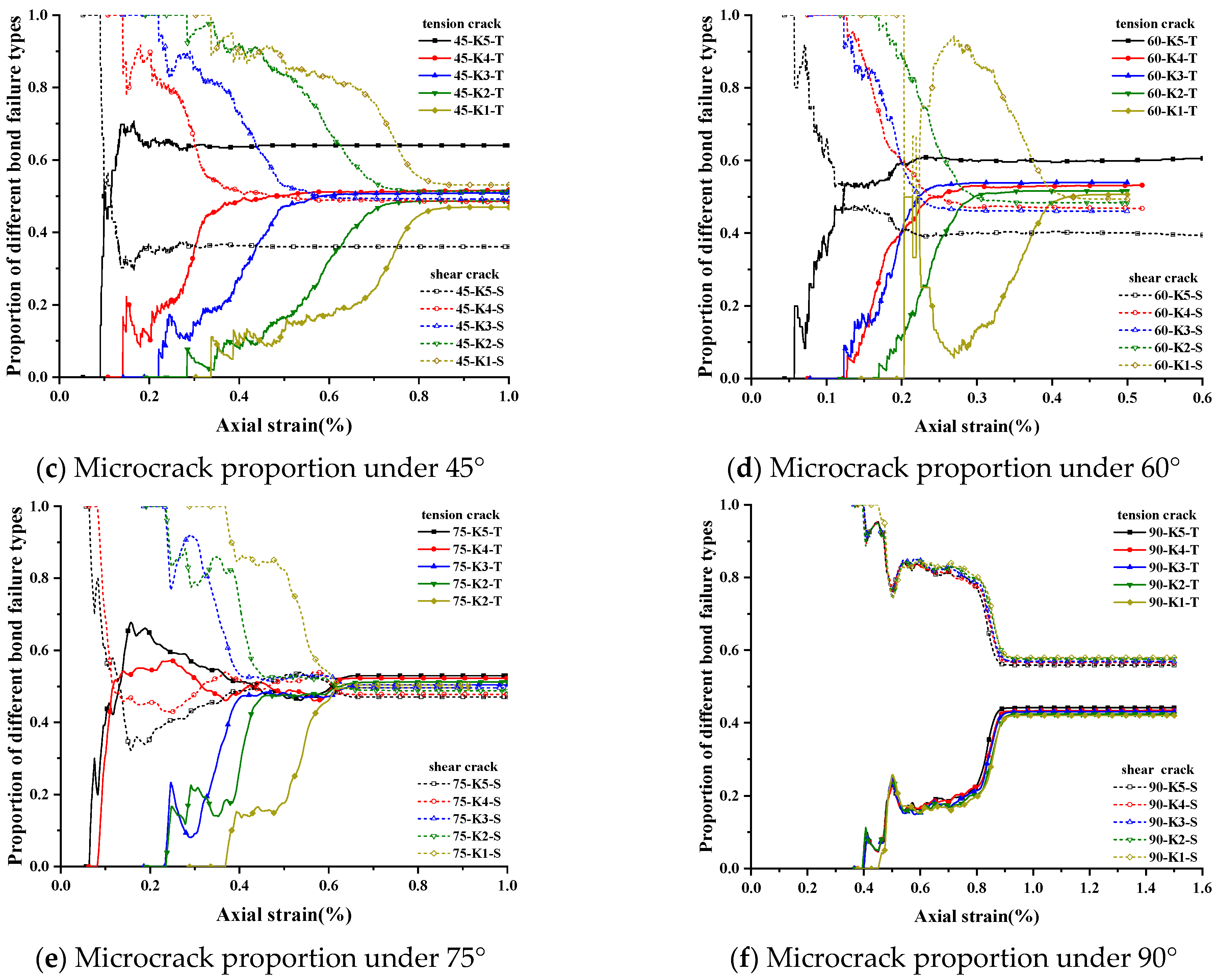




| Uniaxial Compressive Strength (MPa) | Elastic Modulus (GPa) | Poisson’s Ratio | Shear Stiffness (MPa/mm) | Normal Stiffness (MPa/mm) | Friction Angle (°) | |
|---|---|---|---|---|---|---|
| Experimental results | 19.2 | 2.54 | 0.26 | 0.81 | 7.8 | 31.79 |
| Numerical results | 18.6 | 2.49 | 0.26 | 0.83 | 7.9 | 28.40 |
| Particle Properties | Value | Bond Properties | Value |
|---|---|---|---|
| 3.3 | 3.0 | ||
| 1.0 | 3.0 | ||
| 1.66 | 18 ± 1.8 | ||
| 0.5 | 12 ± 1.2 | ||
| 3.0 | 0.3 | ||
| 2020 | 0.5 |
| Parameters | Value |
|---|---|
| 85 | |
| 20 | |
| 0.8 |
Publisher’s Note: MDPI stays neutral with regard to jurisdictional claims in published maps and institutional affiliations. |
© 2022 by the authors. Licensee MDPI, Basel, Switzerland. This article is an open access article distributed under the terms and conditions of the Creative Commons Attribution (CC BY) license (https://creativecommons.org/licenses/by/4.0/).
Share and Cite
Cao, R.; Dai, H.; Yao, R.; Lin, H.; Li, K. Failure Behaviour of Jointed Rock Masses with 3D Nonpenetrating Joints under Uniaxial Compression: Insights from Discrete Element Method Modelling. Appl. Sci. 2022, 12, 11027. https://doi.org/10.3390/app122111027
Cao R, Dai H, Yao R, Lin H, Li K. Failure Behaviour of Jointed Rock Masses with 3D Nonpenetrating Joints under Uniaxial Compression: Insights from Discrete Element Method Modelling. Applied Sciences. 2022; 12(21):11027. https://doi.org/10.3390/app122111027
Chicago/Turabian StyleCao, Rihong, Hua Dai, Rubing Yao, Hang Lin, and Kaihui Li. 2022. "Failure Behaviour of Jointed Rock Masses with 3D Nonpenetrating Joints under Uniaxial Compression: Insights from Discrete Element Method Modelling" Applied Sciences 12, no. 21: 11027. https://doi.org/10.3390/app122111027
APA StyleCao, R., Dai, H., Yao, R., Lin, H., & Li, K. (2022). Failure Behaviour of Jointed Rock Masses with 3D Nonpenetrating Joints under Uniaxial Compression: Insights from Discrete Element Method Modelling. Applied Sciences, 12(21), 11027. https://doi.org/10.3390/app122111027









